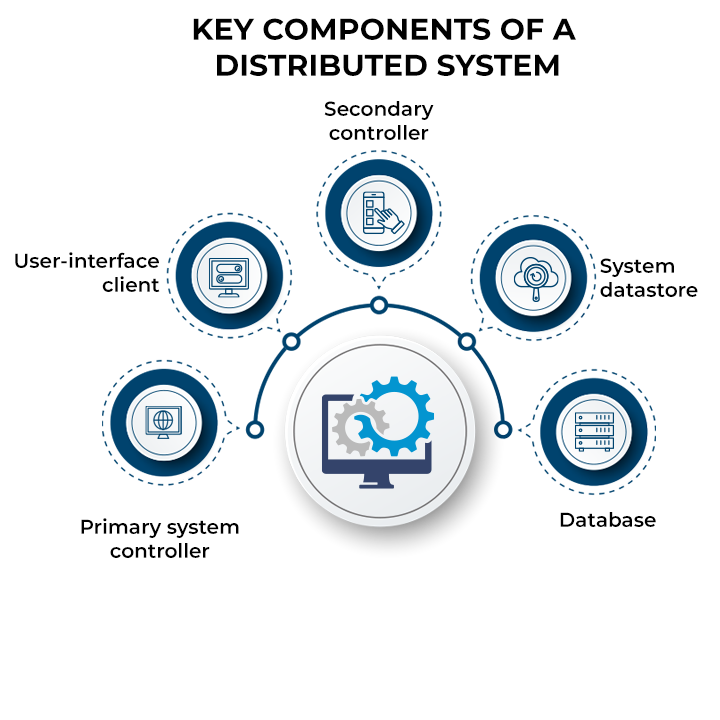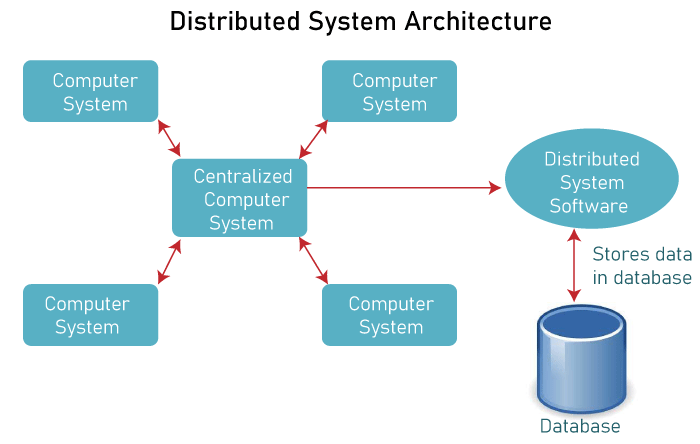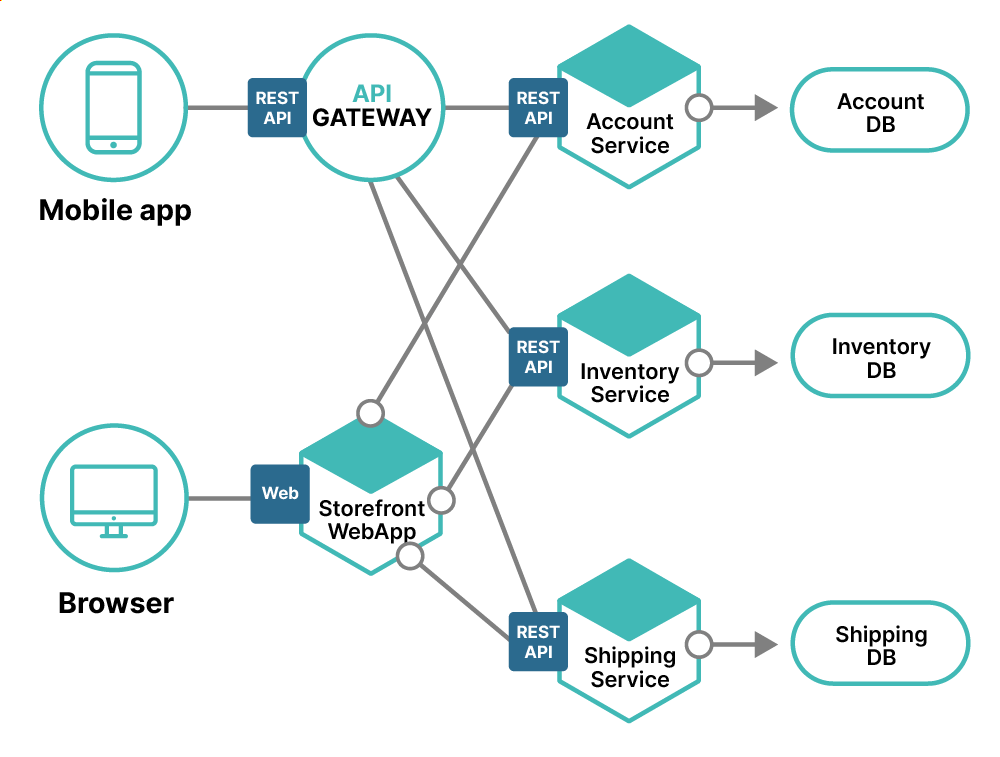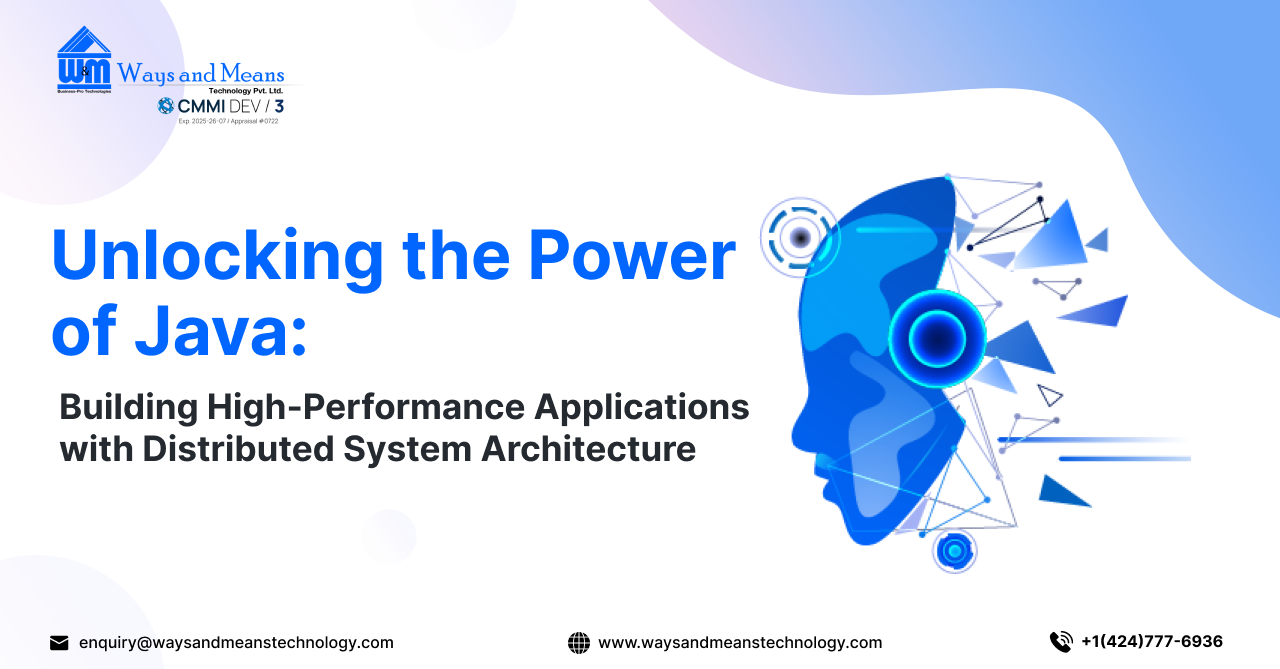What exactly are distributed systems?
A distributed system architecture is one in which components in various places communicate and coordinate their actions to achieve a shared purpose. The utilization of distributed systems is frequently utilized to improve performance, reliability, and scalability.
A distributed system architecture is one in which components in various places communicate and coordinate their actions to achieve a shared purpose. The utilization of distributed systems is frequently utilized to improve performance, reliability, and scalability.
- In this architecture, information processing is dispersed over numerous independent computers rather than being constrained to a single machine.
- The client-server design, which serves as the foundation for multi-tier architectures, can demonstrate a distributed system; alternatives include the broker architecture, such as CORBA, and the Service-Oriented design (SOA).
- To support distributed architectures, numerous technology frameworks are available, including.NET, J2EE, CORBA,.NET Web services, AXIS Java Web services, and Globus Grid services.
- Middleware is a type of infrastructure that facilitates the development and execution of distributed applications. It acts as a barrier between apps and the network.
- It is located in the center of the system and administers or supports the many components of a distributed system. Transaction processing monitors, data converters, and communication controllers are a few examples.
What are Types of Distributed System?
There are numerous types of distributed systems, but they all have basic traits in common. These features are as follows:
- Decentralization: Distributed systems are managed by multiple entities rather than a single entity. Instead, they are composed of separate components that communicate with one another.
- Heterogeneity: Distributed systems are frequently composed of several types of components. These components may run on multiple systems and employ various programming languages.
- Transparency: Users should be able to see what is going on with distributed systems. The fact that users are engaging with a distributed system should be hidden from them.

Distributed systems are frequently utilized to solve complicated problems that a centralized system would find difficult or impossible to solve. Distributed systems, for example, can be used to:
- Process massive quantities of data while maintaining high availability
- Improve performance and scalability
Advantages of Distributed Systems
Distributed systems can be difficult to design and implement, but they can provide several benefits. If you are considering constructing a distributed system, you should carefully analyze your requirements and select the appropriate architecture for your purposes.
The following are some of the advantages of using a distributed system architecture:
- Performance: can be improved by splitting the workload over numerous nodes in distributed systems. This is especially useful for apps that require a high amount of processing power or must handle a huge number of requests.
- Reliability: Because they are less prone to single points of failure, distributed systems can be more reliable than centralized systems. If one node fails, the remaining nodes can continue to function.
- Scalability: Scalable distributed systems can satisfy the needs of increasing businesses. More nodes can be added to the system as the firm expands to manage the additional traffic.
| Concept | Description |
| Resource sharing | Sharing of hardware and software resources |
| Openness | Flexibility of using hardware and software of different vendors |
| Concurrency | Concurrent processing to enhance performance |
| Scalability | Increased throughput by adding new resources |
| Fault tolerance | The ability to continue in operation after a fault has occurred |

Disadvantages of Distributed Systems
Here are some of the difficulties associated with employing a distributed system architecture:
- Complexity: Designing and implementing distributed systems can be difficult. It is critical to thoroughly evaluate the application’s requirements and to select the appropriate architecture for the business’s needs.
- Security: Distributed systems are more susceptible to security breaches than centralized systems. It is critical to put in place security measures to protect the system from assault.
- Cost: Developing and maintaining distributed systems might be more expensive than developing and maintaining centralized systems. When deciding whether to adopt a distributed design, it is critical to consider the system’s cost.
Overall, distributed system architecture can provide numerous advantages to firms looking to improve performance, dependability, and scalability. However, before deciding whether to adopt this form of architecture, it is critical to thoroughly analyse the challenges of employing a distributed system.
| Concept | Description |
| Complexity | More complex than centralized systems |
| Security | More susceptible to external attack |
| Manageability | More effort required for system management |
| Unpredictability | Unpredictable responses depending on the system organization and network load |

How is centralized system different from Distributed systems ?
| Criteria | Centralized system | Distributed System |
| Economics | Low | High |
| Availability | Low | High |
| Complexity | Low | High |
| Consistency | Simple | High |
| Scalability | Poor | Good |
| Technology | Homogeneous | Heterogeneous |
| Security | High | Low |
Example 1 of Distributed System Architecture
One example of a distributed system architecture that many people can relate to is the architecture behind popular social media platforms like Facebook.
Social media platforms like Facebook have millions or even billions of users who interact with each other, share content, and perform various activities simultaneously. To support such massive scale and provide a seamless user experience, Facebook employs a distributed system architecture. Here’s a simplified overview of how it works:
- Load Balancing: Facebook uses load balancing techniques to distribute incoming user requests across multiple servers. Load balancers distribute the requests in a way that ensures optimal resource utilization and prevents any single server from being overwhelmed. This helps maintain high availability and responsiveness of the platform.
- Content Distribution: Facebook employs content delivery networks (CDNs) to efficiently distribute and cache content across multiple servers located in different regions. When a user requests content, such as images or videos, the system serves it from the nearest CDN server, reducing latency and ensuring faster content delivery.
- Data Partitioning and Replication: Facebook’s user data is distributed across multiple databases and servers using techniques like data partitioning and replication. Partitioning involves dividing the user data into smaller subsets based on certain criteria (e.g., user ID ranges or geographic location) and storing each subset on different database servers. Replication involves creating multiple copies of the data for redundancy and improved fault tolerance.
- Messaging and Event Processing: Facebook relies on distributed messaging systems to handle real-time notifications, event processing, and messaging between users. These systems allow users to receive instant notifications when someone interacts with their content, sends them a message, or performs any other relevant action.
- Distributed File System: Facebook employs a distributed file system, such as the Haystack file system, to store and manage large amounts of media files uploaded by users. This system distributes files across multiple storage servers, allowing efficient retrieval and storage of user-generated content.
- Global Data Centers: Facebook operates multiple data centers worldwide to ensure proximity to users and reduce network latency. These data centers work together in a distributed manner, sharing data and synchronizing updates to maintain a consistent user experience across different regions.
By adopting a distributed system architecture, Facebook can handle a massive user base, provide real-time interactions, maintain high availability, and scale horizontally to accommodate increasing demands. This architecture enables seamless content delivery, efficient data storage and retrieval, and the ability to handle unpredictable spikes in user activity, making Facebook a widely accessible and reliable social media platform.
Example 2 of Distributed System Architecture
Most modern web and blockchain systems are supported by distributed computing systems; nonetheless, let’s look at some specific examples of systems that have largely superseded old client-server systems. A microservice architecture, in which each computer function is separated into its own service, is a common component of a distributed system.

This is a simple e-commerce program that accepts orders from clients via mobile apps or web browsers and then handles order fulfillment using a succession of linked APIs, each with its own database. The advantage of this architecture is that any of these components can easily be replaced with a different technology without affecting the overall system.
Java Distributed System Architecture
Java with Spring Boot is an excellent choice for building applications using a distributed system architecture. By leveraging the capabilities of Java and the Spring Boot framework, developers can create robust, scalable, and highly available applications that are well-suited for distributed environments. Here’s an explanation aimed at potential clients:
Java, as a programming language, offers several advantages for distributed system architecture. It provides a wide range of libraries, frameworks, and tools that simplify the development process and enable seamless integration with distributed technologies. When combined with Spring Boot, a popular Java framework for building enterprise applications, the power of Java is amplified, making it an ideal choice for developing distributed applications.
- Simplified Development: Java’s extensive ecosystem and Spring Boot’s convention-over-configuration approach streamline development efforts. The Spring Boot framework abstracts away the complexities of distributed systems, allowing developers to focus on business logic and application functionality. It provides pre-built components and modules for handling distributed aspects like load balancing, service discovery, and fault tolerance.
- Distributed Communication: Java with Spring Boot excels in enabling efficient communication between distributed components. It supports various communication protocols such as RESTful APIs, messaging systems like Apache Kafka, and RPC frameworks like gRPC. These communication mechanisms facilitate seamless interaction and data exchange between different parts of the distributed system.
- Scalability and Performance: Java’s multi-threading capabilities and Spring Boot’s support for scalable architectures empower applications to handle increasing workloads. Distributed systems built with Java and Spring Boot can easily scale horizontally by adding more servers or instances to handle higher traffic. This elasticity ensures that the application can maintain optimal performance even during peak usage periods.
- Fault Tolerance and Resilience: Java’s robust exception handling, combined with Spring Boot’s fault-tolerant features, ensures that the application can gracefully recover from failures and continue functioning seamlessly. Distributed systems built with Java can leverage Spring Boot’s circuit breaker pattern, retry mechanisms, and failover strategies to handle errors and mitigate the impact of failures.
- Integration with Distributed Technologies: Java with Spring Boot seamlessly integrates with popular distributed technologies such as Apache ZooKeeper, Apache Cassandra, Apache Kafka, and more. These technologies provide essential functionalities like distributed coordination, distributed databases, and messaging systems, enhancing the capabilities of the application and supporting a distributed architecture.
- Industry Support and Community: Java has a vast and active developer community, ensuring continuous improvement, updates, and support for distributed system development. Additionally, Spring Boot has gained widespread adoption and has a thriving community that contributes to its ecosystem, providing resources, libraries, and expertise.
In summary, Java with Spring Boot is an excellent choice for building applications using a distributed system architecture. It simplifies development, enables efficient communication between distributed components, supports scalability and fault tolerance, seamlessly integrates with distributed technologies, and benefits from a strong industry and community support. These advantages make Java with Spring Boot a compelling option for developing distributed applications that can meet the requirements of modern, scalable, and resilient systems.

Introducing Ways and Means Technology: Your Reliable Java Application Development Partner
Are you looking for a dependable partner to help you create high-quality, architecturally sound applications for your company? Take a look at Ways and Means Technology. We are the finest solution for meeting your software demands because of our expertise in Java application development and in-depth understanding of distributed system design.
At Ways and Means Technology, we understand the importance of distributed system architecture in developing resilient and scalable systems. Our expert Java engineers have in-depth knowledge of distributed computing principles and procedures. We combine the power of Java and its ecosystem with our knowledge of Spring Boot to create apps that excel in distributed situations.
Why Choose Ways and Means Technology for Your Java Application Development?
- Comprehensive Understanding: Our team thoroughly comprehends the intricacies of distributed system architecture. We grasp the challenges and complexities that arise when developing applications to function seamlessly across distributed nodes. This knowledge empowers us to design solutions that optimize performance, scalability, fault tolerance, and data consistency.
- Streamlined Development: With our expertise in Java and Spring Boot, we simplify the development process for distributed applications. By abstracting away the complexities, we enable our developers to focus on crafting efficient and reliable code that meets your business requirements. This approach allows us to deliver applications within shorter timeframes without compromising on quality.
- Scalability and Performance: We understand the significance of scalability in today’s business landscape. Leveraging Java’s multithreading capabilities and Spring Boot’s scalable architectures, we build applications that can handle increased workloads without sacrificing performance. Our solutions are designed to seamlessly scale horizontally, ensuring your application grows alongside your business.
- Robustness and Fault Tolerance: At Ways and Means Technology, we prioritize the robustness and fault tolerance of your applications. We implement best practices to handle failures, ensuring your systems can gracefully recover and continue operating smoothly. By leveraging Spring Boot’s fault-tolerant features, such as circuit breakers and retry mechanisms, we mitigate the impact of potential failures.
- Seamless Integration: Our Java development expertise extends to seamlessly integrating your applications with popular distributed technologies. We are proficient in working with technologies such as Apache ZooKeeper, Apache Cassandra, and Apache Kafka, enabling us to build applications that leverage distributed databases, messaging systems, and coordination frameworks.
- Client-Centric Approach: We believe in forging strong partnerships with our clients. Our team takes the time to understand your unique business requirements, goals, and challenges. We collaborate closely with you throughout the development process, ensuring that the final solution aligns perfectly with your needs and exceeds your expectations.
Choose Ways and Means Technology for Exceptional Java Application Development
When it comes to Java application development with a focus on distributed system architecture, Ways and Means Technology is the ideal partner. Our deep understanding of distributed computing principles, combined with our expertise in Java and Spring Boot, sets us apart from the competition.
Trust us to deliver scalable, high-performance, and fault-tolerant applications that drive your business forward. Contact Ways and Means Technology today to embark on a transformative journey of Java application development services tailored to your specific needs.

What is a distributed system?
A distributed system is a software system that is composed of multiple autonomous components that are located on different computers and communicate with each other over a network. Distributed systems are used in a wide variety of applications, including e-commerce, social networking, and cloud computing.
Ways and Means Technology has extensive experience in designing, developing, and deploying distributed systems. We have a team of experienced engineers who have a deep understanding of the challenges and risks of distributed systems. We use a variety of security controls to mitigate the risks of distributed systems, and we use a variety of scalability controls to ensure that our systems can handle growth.
What are the advantages of using a distributed system architecture for my application?
Distributed system architecture offers benefits such as scalability, fault tolerance, increased performance, resource sharing, and flexibility. At Ways and Means Technology, we understand the importance of these advantages and ensure that our application development process leverages distributed system architecture to maximize these benefits for your project.
How does distributed system architecture handle scalability?
Distributed system architecture enables horizontal scalability by adding more resources (nodes) to handle increased workloads. At Ways and Means Technology, we design applications with scalability in mind, ensuring they can seamlessly handle growing user demands by distributing the workload across multiple nodes.
What measures are taken to ensure fault tolerance in a distributed system architecture?
Ways and Means Technology implements fault-tolerant strategies in our projects. We use techniques such as data replication, redundancy, and failover mechanisms to ensure that your application can continue operating even in the presence of failures or faults.
How do you ensure data consistency in a distributed system architecture?
We employ techniques such as distributed transactions and consistency models to maintain data consistency across distributed nodes. Our experienced team at Ways and Means Technology carefully designs and implements the appropriate mechanisms to guarantee data integrity and consistency in your application.
How does Ways and Means Technology ensure the security of my distributed application?
We prioritize the security of your application by implementing robust authentication, authorization, and encryption mechanisms. Our team follows industry best practices and incorporates security measures at every level of the application development process to protect your data and infrastructure from external threats.
How do you handle communication between different components in a distributed system?
Ways and Means Technology leverages various communication protocols such as RESTful APIs, messaging systems like Apache Kafka, and RPC frameworks to ensure efficient and reliable communication between distributed components. We carefully select the most suitable communication mechanism based on your project requirements.
How do you handle data storage and retrieval in a distributed system architecture?
We use distributed databases and storage systems to handle data storage and retrieval efficiently. Ways and Means Technology has expertise in technologies such as Apache Cassandra, MongoDB, and distributed file systems, enabling us to design robust data storage solutions tailored to your application’s needs.
How does Ways and Means Technology ensure performance optimization in a distributed system?
Our team conducts thorough performance analysis and optimization during the application development process. We utilize caching mechanisms, load balancing techniques, and performance monitoring tools to identify and address any bottlenecks, ensuring optimal performance in your distributed application.
What level of control and visibility will I have over the distributed system architecture?
Ways and Means Technology believes in transparency and collaboration. Throughout the development process, we provide regular updates, conduct meetings, and maintain open lines of communication, giving you full visibility and control over the project. We involve you in architectural decisions to ensure that the distributed system architecture aligns with your goals.
How does Ways and Means Technology provide ongoing support and maintenance for distributed applications?
We offer comprehensive support and maintenance services for your distributed applications. Our team is readily available to handle any issues, provide updates, and perform routine maintenance tasks. We follow industry best practices to ensure the long-term stability and performance of your distributed application.
What are the benefits of using a distributed system?
The benefits of using a distributed system include:
- Increased scalability: Distributed systems can be scaled to handle more users and more traffic. This is because the load can be distributed across multiple nodes.
- Increased reliability: Distributed systems can be more reliable than centralized systems because they are not as susceptible to single points of failure. If one node fails, the other nodes can continue to operate.
- Increased availability: Distributed systems can be more available than centralized systems because they can continue to operate even if one or more nodes fail. This is because the load can be distributed across multiple nodes.
- Reduced costs: Distributed systems can reduce costs by allowing businesses to consolidate their IT infrastructure. This is because multiple applications can be hosted on a single server.
Ways and Means Technology takes advantage of all of these benefits in our projects and application development process. We design our systems to be scalable, reliable, and available. We also use a variety of techniques to reduce costs, such as hosting multiple applications on a single server.
What are the challenges of using a distributed system?
The challenges of using a distributed system include:
- Complexity: Distributed systems can be complex to design, develop, and manage. This is because they involve multiple components that are located on different computers.
- Security: Distributed systems can be more vulnerable to security attacks than centralized systems. This is because they have a larger attack surface.
- Performance: Distributed systems can be less performant than centralized systems if they are not designed and implemented properly. This is because the communication between nodes can add latency.
Ways and Means Technology is aware of these challenges and takes steps to mitigate them. We use a variety of techniques to design and implement distributed systems that are secure, performant, and easy to manage.




